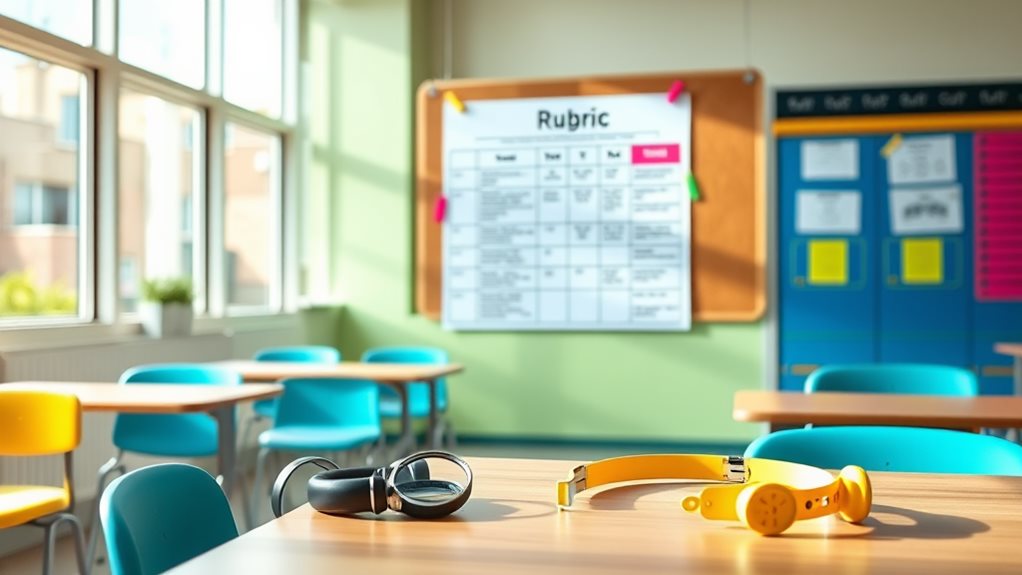Rubric-based grading enhances accessibility for students with disabilities by providing clear, structured, and transparent assessment criteria. You'll find that rubrics break down assignments into manageable components, reducing ambiguity and anxiety. They empower students to understand expectations, track progress, and reflect on their work. Customizable rubrics accommodate diverse learning styles and align with individual IEP goals, fostering inclusivity and confidence. By using tools like Rubistar or RubricMaker, you can create tailored assessments that support every learner. Discover how to implement these strategies effectively in your classroom.
Understanding Rubric-Based Grading

Rubric-based grading is your key to creating a transparent, consistent, and accessible assessment process for all students, especially those with disabilities. At its core, a rubric breaks down an assignment into specific criteria and performance levels, making expectations crystal clear before students even begin. This clarity isn't just helpful—it's transformative. It empowers students to understand exactly what success looks like and how to achieve it.
Imagine a student with a disability struggling to decode vague instructions. With a rubric, you're giving them a roadmap. They can see the criteria for each level of performance, from "emerging" to "exceeding expectations," and self-monitor their progress as they work. This self-awareness fosters independence and builds confidence, which are critical components of academic growth.
Here's why rubric-based grading stands out:
- Clarity: By outlining specific expectations, you eliminate guesswork and uncertainty.
- Consistency: It ensures fair and uniform evaluation across different assignments and subjects.
- Feedback: Rubrics provide actionable insights, showing students where they excelled and where they can improve.
- Accessibility: Tailored rubrics can accommodate diverse learning styles and needs, leveling the playing field for students with disabilities.
But the benefits don't stop with the students. Rubrics also simplify grading for you. Instead of sifting through hazy standards, you have a clear framework to assess each component of an assignment. This saves time and reduces bias, ensuring that grades reflect actual performance rather than subjective judgments.
Moreover, rubrics are a powerful tool for parents and guardians. They make the grading process transparent, showing how a student's work aligns with their IEP goals or general academic standards. When parents can see the criteria and the progress, they become better partners in their child's education.
In short, rubric-based grading isn't just a method—it's a mindset. It's about creating a structured, inclusive environment where every student has the tools to succeed and the understanding of how to use them. And for students with disabilities, this can be the difference between frustration and achievement.
Benefits of Rubrics for Students With Disabilities
Rubrics offer a clear roadmap for students with disabilities, ensuring they know exactly what's expected to succeed in their assignments. By breaking down tasks into specific criteria, these tools help students understand the standards they're aiming for, reducing ambiguity and anxiety. This clarity is especially crucial for students who may struggle with executive functioning or processing instructions independently.
Using rubrics also empowers students to monitor their own progress and reflect on their work. They can track how well they're meeting each criterion, identify areas for improvement, and take ownership of their learning journey. This self-monitoring fosters independence and resilience—skills that are invaluable both in and out of the classroom.
For students with disabilities, peer assessment becomes a meaningful tool when guided by rubrics. The structured criteria make it easier for peers to provide constructive feedback, promoting collaboration and communication. This not only enhances learning but also builds a supportive classroom community where students feel valued and included.
- Rubrics clarify expectations, reducing confusion and stress.
- Students can self-assess and identify strengths and weaknesses.
- Peer feedback becomes more structured and constructive.
Customizable rubrics are another game-changer. You can tailor them to accommodate diverse learning styles and needs, ensuring that every student has a fair chance to demonstrate their knowledge and skills. For instance, a rubric might include alternative ways to meet criteria, such as oral presentations instead of written essays, or visual projects in lieu of traditional reports.
This flexibility boosts engagement and motivation, helping students feel more confident in their abilities. Research consistently shows that rubrics lead to higher satisfaction among teachers and parents. They provide a transparent framework for assessing student work, making it easier to communicate progress and set achievable goals.
When everyone—students, educators, and families—clearly understands the expectations, it creates a more cohesive and effective learning environment.
Types of Rubrics and Their Applications

When evaluating student work, choosing the right rubric type can make all the difference—especially when it comes to accessibility for students with disabilities. Let's break down the two main types of rubrics and how they can be applied effectively.
Analytic Rubrics
Analytic rubrics dissect assignments into specific criteria, allowing you to score each component individually. This granular approach is particularly useful for students with disabilities, as it pinpoints exactly where they excel or struggle. For example, if you're grading a writing assignment, you might separate criteria like grammar, content, and organization. This clarity helps students understand what they need to focus on and gives you actionable insights to guide their learning.
- Example: A student with dyslexia might struggle with grammar but excel in creative ideas. An analytic rubric lets you recognize their strengths while providing targeted support for their weaker areas.
- Application: Use analytic rubrics for complex assignments where breaking down tasks into smaller, manageable parts can reduce overwhelm and foster progress.
Holistic Rubrics
Holistic rubrics, on the other hand, assess the overall quality of a completed work without separating individual components. This approach is ideal when tasks are interconnected, and the emphasis is on the final product rather than specific elements. For students with disabilities, holistic rubrics can reduce cognitive load by focusing on the big picture rather than minute details.
- Example: In a group project, a holistic rubric might evaluate teamwork, creativity, and presentation as a whole. This benefits students who might struggle with executive functioning but shine in collaborative settings.
- Application: Choose holistic rubrics for tasks where the process and end result are more important than individual steps, or when you want to simplify grading for time-sensitive projects.
Why Rubrics Matter for Accessibility
Both analytic and holistic rubrics serve a critical purpose: they clarify expectations. For students with disabilities, this transparency is invaluable. Knowing exactly what's required before starting an assignment reduces anxiety and builds confidence.
Additionally, rubrics encourage self-monitoring and peer assessment, fostering accountability and awareness of quality—skills that are transferable across all learning environments.
– Pro Tip: Customize rubrics to align with the unique needs of your students. For instance, adjust scoring criteria or include visual cues for students who benefit from alternative formats.
Choosing the right rubric isn't just about making grading easier—it's about creating an inclusive learning environment where every student, regardless of ability, can thrive. Whether you opt for the precision of analytic rubrics or the simplicity of holistic ones, the goal is to provide clarity, support, and opportunities for growth.
Creating Effective Rubrics for Diverse Needs
Creating effective rubrics for diverse needs requires a tailored approach that ensures every student can thrive, especially in special education settings. Start by making your rubrics customizable to address the unique skills and needs of each learner. This isn't just about fairness—it's about fostering individualized learning experiences that empower students to succeed.
When designing your rubric, incorporate a variety of criteria to provide a comprehensive assessment of student performance. Think beyond just task completion—consider engagement, communication, effort, and problem-solving. For example, a rubric for a group project might include criteria like:
- Active participation in discussions
- Clear and respectful communication with peers
- On-task behavior during collaboration
- Quality of the final product
These diverse criteria allow you to capture a fuller picture of student abilities and areas for growth.
Utilize editable rubrics to make modifications seamless and efficient. This flexibility is crucial when aligning with specific learning objectives in a student's Individualized Education Program (IEP). For instance, if a student's IEP focuses on improving verbal communication, you can adjust the rubric to prioritize speaking skills during presentations or group activities. This ensures your grading tool remains a direct reflection of their personalized goals.
Individualized rubrics also serve as powerful tools for tracking progress over time. By consistently using these tailored assessments, you can monitor growth and identify patterns in student performance. Encourage students to self-monitor and reflect by sharing the rubric with them before and after tasks. This transparency helps them understand expectations and take ownership of their learning journey.
Finally, involve students in the rubric creation process whenever possible. Ask them what they think success looks like for a particular task or project. This engagement not only clarifies expectations but also builds their confidence and investment in the learning process. For example, a student might suggest adding "trying my best" as a criterion, which can then be integrated into the rubric as a measure of effort and perseverance.
Implementing Rubrics in Inclusive Classrooms

Inclusive classrooms thrive on clarity and consistency, and rubrics are your secret weapon for achieving both. When you implement rubrics, you're not just assigning grades—you're building a framework that supports all learners, including students with disabilities. This approach ensures that expectations are transparent, feedback is actionable, and progress is measurable.
Start by designing rubrics that align with the diverse needs of your students. For instance, a student with a learning disability may struggle with traditional written assignments but excel in verbal demonstrations. A customized rubric can include criteria for oral presentations, reducing barriers and allowing them to showcase their understanding. By tailoring rubrics to individual IEP goals, you ensure that assessment is both fair and meaningful.
Consider using a 3-2-1-0 rating scale to provide clarity. This structure breaks down competencies into specific levels, such as "Exceeds Expectations," "Meets Expectations," "Needs Improvement," and "Not Demonstrated." For students with disabilities, this granularity helps them understand exactly where they stand and what steps they need to take to improve. It also empowers them to self-monitor their progress, fostering a sense of ownership over their learning.
- Focus on key skills: Create rubrics that emphasize functional skills like engagement, prompting, or social interaction, which are often central to IEP goals.
- Incorporate peer assessment: Use rubrics to guide students in evaluating each other's work, promoting collaboration and mutual support.
- Provide clear feedback: Use rubric-based feedback to highlight strengths and pinpoint areas for growth in a way that's easy for students and parents to understand.
Research shows that rubrics enhance communication between educators, students, and families. When you use rubrics effectively, you're not just grading—you're fostering trust, accountability, and a shared understanding of progress. This is especially critical in inclusive classrooms, where every student deserves the opportunity to succeed on their own terms.
Tools and Resources for Developing Rubrics
To develop rubrics that truly meet the needs of your students, especially those with disabilities, leverage tools and resources designed to simplify the process while ensuring accessibility. Rubistar and Teach-nology are two standout rubric generators that allow you to customize grading criteria to align with specific learning objectives. These platforms provide templates that you can adapt to focus on measurable outcomes, such as task completion, participation, or communication skills, tailored to individual student needs.
For a more hands-on approach, consider using RubricMaker, which lets you design rubrics from scratch. This tool is particularly useful when you're looking to incorporate accommodations like extended time, modified assignments, or alternative response methods. By creating individualized rubrics, you can track progress and growth in a way that's meaningful for each student.
Here's how you can maximize these resources:
- Examine models of effective rubrics to understand how they're structured and scored.
- Engage your students in the rubric creation process to foster ownership and clarity about expectations.
- Use software tools to ensure your rubrics are consistent, fair, and accessible across all subjects and grade levels.
Measuring Progress and Providing Feedback
Rubrics are your ultimate tool for measuring progress and delivering targeted feedback that drives student growth. By breaking down assignments into specific criteria, you create a clear roadmap for students to follow—and for you to assess their performance. The key lies in using a 3-2-1-0 rating scale, which provides a consistent framework for evaluating work. This scale ensures that your feedback is actionable and directly tied to the learning objectives, making it easier for students to understand where they excel and where they need improvement.
- Specificity is Key: Rubrics allow you to pinpoint exactly where students are struggling or thriving. For example, if a student scores a "2" on "Argument Development" but a "1" on "Evidence Use," you know precisely where to focus your feedback.
- Self-Monitoring Made Easy: When students can see the rubric before they start, they're empowered to self-assess their work as they go. This fosters independence and helps them take ownership of their learning.
- Early Intervention: For students with disabilities, rubric-based feedback can highlight areas where additional instruction or accommodations are needed. This allows you to intervene early and provide the necessary support.
Customizing rubrics to align with Individualized Education Programs (IEPs) ensures that assessments are both fair and meaningful. For instance, if a student's IEP includes goals for improving writing clarity, you can adjust the rubric to emphasize this skill. This tailored approach ensures that every student's progress is measured against their unique learning goals.
Rubrics aren't just about grading—they're about growth. By providing detailed, criterion-based feedback, you're not only helping students improve their current work but also equipping them with the skills to succeed in future assignments. It's a win-win: students gain clarity, and you save time by streamlining your feedback process.
Questions and Answers
What Are the Grading Implications for Students With Disabilities?
Grading fairness for students with disabilities requires individualized assessments that reflect their unique progress. You'll find accommodations impact equity in grading by addressing diverse learning needs, ensuring evaluations align with IEPs and accurately measure achievement.
Should Students With Disabilities Be Graded Using the Same Grading Systems as Their Peers?
You shouldn't grade students with disabilities using the same systems as their peers if it undermines equity in assessments. Individualized grading practices and alternative evaluation methods ensure inclusive learning environments and promote fairness in education.
How Do Students With Special Needs Benefit From the Use of Grading Rubrics?
Rubric clarity ensures you understand task expectations, while performance transparency lets you track progress. You gain student autonomy by self-assessing, and feedback consistency helps refine skills, enhancing your overall task understanding and academic success.
What Is Standards-Based Grading for Special Education Students?
Standards-based grading aligns learning goals with standards, ensuring individualized assessment tailored to your needs. You'll work toward performance benchmarks, focusing on skill mastery. Educators provide instructional feedback to track progress and support your academic growth effectively.
